
LTD 1/48 PZL P.11c
| KIT #: | 9803 |
| PRICE: | |
| DECALS: | One option |
| REVIEWER: | Pablo Calcaterra |
| NOTES: |
Short
run kit. |

| HISTORY |
Władysław Gnyś was born in a small rural house in Poland on August 24, 1910. The Great War meant lots of suffering for the Poles. In 1915 with his father, Władek witnesses a dogfight and a plane crashing down in flames. Later on and inspired by the developing Polish aviation and his uncle who was a high ranking member of the Air Force, he joined the armed forces of his country in 1931 (4th Air Regiment in Toruń).
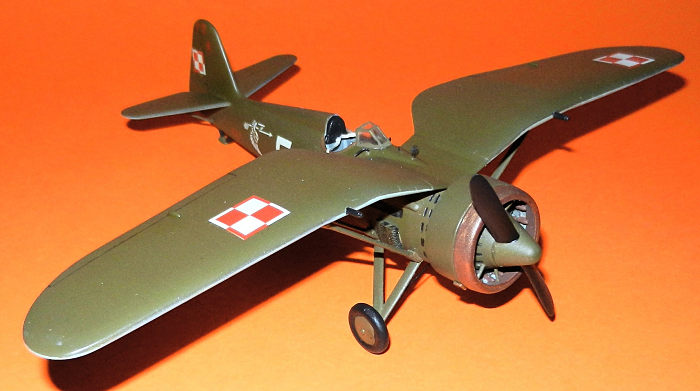 In 1933 he started Flying Training as an NCO. Flying Breguet XIX was
very complicated as it was an unforgiving machine. During one of his flights the
plane went into a spin without warning. Only a few hundred feet above the
ground, he managed to pull the plane out of the spiral. Unbeknown to him,
officers were watching from the ground and praised his skills. He was able to
show the technique he used to save the day to other cadets and pilots.
In 1933 he started Flying Training as an NCO. Flying Breguet XIX was
very complicated as it was an unforgiving machine. During one of his flights the
plane went into a spin without warning. Only a few hundred feet above the
ground, he managed to pull the plane out of the spiral. Unbeknown to him,
officers were watching from the ground and praised his skills. He was able to
show the technique he used to save the day to other cadets and pilots.
In 1934 Gnyś started Fighter School and graduated first in his class. As a Fighter pilot he joined 142 Fighter Sqn in 1935 as an NCO. He was involved in an air crash flying a PZL P.7. The other pilot perished in the accident but he managed to land back safely minus one landing gear leg that had been torn away by the other plane. He received a written praise for saving the plane and the Bronze Cross of Merit.
In 1936 he joined the Polish Air Force Academy in Dęblin and there he became an instructor. Finally in 1938 he was able to join the Officer Cadet School. In June 1939, he joined 121 Eskadra close to Kraków.
War:
With three squadrons of PZL P.11cs, they moved to Balice (west of Kraków) to await the imminent war. They were in a very large field with their planes properly dispersed and camouflaged. The pilots were billeted in a large private home close by.
In the early hours of September 1st he was awaken
by explosions and planes flying overhead. Kraków
in the horizon was on fire. The C.O. Capt Medwecki yelled at Gnyś ordering him
to take off with him. Taking off in formation still in darkness, they climbed to
1,000 ft when tracers flashed in front of him. He turned sharply to the left and
dove to the ground. He managed to pull above the treetops avoiding the Stukas
that had shot down his leader. Recovering his composure, Gnyś climbed and shot
at one of the Stukas that turned and hid in a cloud. With no more enemies
around, he climbed to wait for the Germans to return after bombing Kraków.
Two Do17s were flying 3,000 ft below. Diving almost vertically, Władek picked
the plane on the right. Facing the returning fire from the German gunner, Gnyś
fired back hitting the enemy. He climbed and dove again attacking for a second
time hitting the cockpit. This time he continued his desce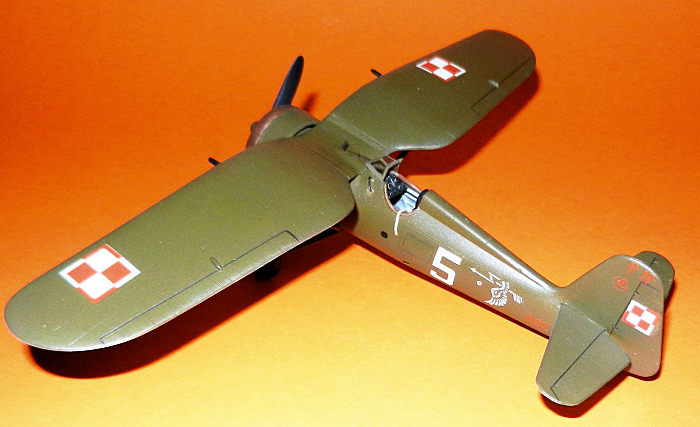 nt in order to climb
and attack again. When he reached the height where the Do17s were supposed to
be, he could not find them. Unbeknown to him the bomber he had attacked had
crashed with its wingman and both hit the ground in the Village of Żurada. He
saw a He111 in the distance and attacked it, but after his first burst, he ran
out of ammo. The Do17Es belonged to KG77 (one of them was coded 3Z+FR) … there
were no survivors.
nt in order to climb
and attack again. When he reached the height where the Do17s were supposed to
be, he could not find them. Unbeknown to him the bomber he had attacked had
crashed with its wingman and both hit the ground in the Village of Żurada. He
saw a He111 in the distance and attacked it, but after his first burst, he ran
out of ammo. The Do17Es belonged to KG77 (one of them was coded 3Z+FR) … there
were no survivors.
Thus at roughly 7 am on September 1st 1939, W. Gnyś had achieved the first aerial victory for Poland and (future) Allies. The first victim of the entire air war was that of his C.O. M. Medwecki under the guns of Stuka pilot Frank Neubert. Recent book by F. Grabowski confirms that S. Skalski’s first kill (the first Allied ace of WWII) was a shared one and happened on the afternoon of the 1st thus correcting information published elsewhere.
Władek's victories are incontestable. Two memorials were constructed in his honour at Żurada (crash site of the German bombers), and at the Polish Aviation Museum in Kraków, plus a street there, proudly displays his name. His sons Stefan and Ashley and Polish families were witness to these very special honours.
On September 9th he damaged another He 111, but running out of ammo, he flew beneath the German bomber and fired at it with his service pistol!
Later on he attacked German ground forces with his plane causing a great number of casualties. On the 17th the order to fly the planes to Romania arrived. Being too sick, he was driven in a car and barely escaped from Soviet tanks and ground forces that fired at them.
Arriving safely in Romania, he managed to board a ship taking Polish Armed Forces members to France on November 6th 1939, arriving to Lyon 14 days later.
In January 1940, France and Poland signed an agreement and as a consequence French/Polish fighter squadrons were established flying MS406 French fighters. Gnyś was one of the first 19 Polish pilots assigned to “Montpellier Squadron”.
On March 27th the pilots were broken up and sent to different French units. Gnyś along with two other pilots were assigned to GC III/1 at Toul-Croix de Metz. As the French pilots did not think the Poles were very good fliers, they agreed to a mock duel in the sky. The first Polish pilot (Kazek Bursztyn) won 2:0, Gnyś 2:1 while the 3rd French pilot decided not to play against Władysław Chciuk as he did not want to suffer the same fate as his two friends. After that exchange, the French truly respected their Polish ally.
On May 10th the Germans hit the French and hard. A number of MS406s were destroyed on the ground at Auchy-au-Bois where GCIII/1 was based. Amid the strafing and falling bombs, S-Lt Gnyś tried to take off, but his own plane was destroyed in front of him, and an unexploded bomb fell nearby!
On May 12th Gnyś participated in the shooting down of a He111 near Antwerp. On the 16th he shared a Do17, a Bf109 on the 25th, and a Ju87 on June 8.
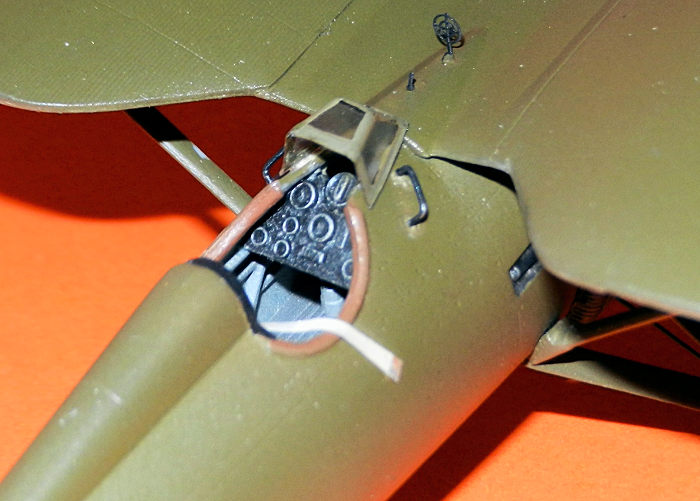 After Lt Bursztyn had been killed on May 25th, S-Lt Gnyś took over
command of the Polish section of three (which flew above the French squadron).
However, during this fatal encounter, his own his MS406 was badly damaged by
many Messerschmitts.
After Lt Bursztyn had been killed on May 25th, S-Lt Gnyś took over
command of the Polish section of three (which flew above the French squadron).
However, during this fatal encounter, his own his MS406 was badly damaged by
many Messerschmitts.
On June 3rd, their planes were caught on the ground again by a surprise attack. Everyone tried to avoid being a target, but not Władek. He bravely ran to his aircraft and off he went after the enemy, but to no avail.
On June 18th General Sikorski ordered all Polish personnel to evacuate France and travel to England. Along with around 4,300 other Polish troops, they managed to board ships from southern France and escaped to North Africa. After an eventful trip by ship, they finally arrived in Liverpool in July 1940.
During the last week of August 1940, Władek and 11 other Polish colleagues joined 302 Sqn based at Leconfield.
He received medals (Croix de Guerre Avec Palme and the Cross of Valour) for his actions in the Battle of France.
On September 9th Gnyś flew a Hurricane for the first time. On September 25th his OTU training ended. For a time, 302 Sqn was part of Douglas Bader’s Big Wing. Based in Northolt from early October, 302 Sqn participated in combats against the Luftwaffe. Gnyś participated in some of these latter stages of the Battle of Britain claiming no victories. It is around this time that he met Barbara who would eventually became his longtime wife.
In 1941 302 Sqn and Gnyś took part in Circus operations over France. On
one occasion he was almost shot down and he managed to nurse his badly damaged
Hurricane back to England barely missing the Cliffs of Dover and made a crash
landing on the first field he was able to find. After convalescing for some
time, he was transferred to CTU Woodlands in October 1941. After returning to
302 Sqn he was assigned to the operations room at RAF Exeter as controller early
in 1942. In August he was transferred to the Operations Room of the famed 303
Kosciuszko Squadron. Back to 302 Sqn he flew some missi ons over France in early
1943. He took the Fighter Command School of Tactics. With 316 Sqn he
participated in missions to protect bombers, took part in Ramrods, Rodeos and
Rhubarbs plus some scrambles from February to August 1943. In March he became
Flight Commander.
ons over France in early
1943. He took the Fighter Command School of Tactics. With 316 Sqn he
participated in missions to protect bombers, took part in Ramrods, Rodeos and
Rhubarbs plus some scrambles from February to August 1943. In March he became
Flight Commander.
With 131 Wing led by A. Gabszewicz Gnyś participated in the actions of D-Day. In August he was promoted to Acting Sqn Leader of 317 “Wilno” Sqn. During his first mission leading the Squadron on August 27th, he was shot down over the Seine River in France by flak flying his Spitfire Mk 9. Wounded and captured by the Germans, he managed to escape from a field hospital, was rescued by the French Resistance and returned to England. Due to his injuries his career as a fighter pilot was over. Still working with the RAF and PAF on ground duties, the war ended.
After the War:
The Gnyś family (two children and Barbara) emigrated from Britain to Canada in 1948 where they worked hard on a farm they bought in the Hamilton, Ontario area. There, the family grew again with a baby girl. Later in Grimsby, a boy was born.
After the fall of the Iron Curtain, W. Gnyś travelled several times to Poland where he was honoured by his Air Force and visited many places where his family had lived before the war, meeting many relatives. Indeed he was even reunited with German Stuka pilot Frank Neubert in Canada on a hot summer day in 1989 where the enemies reconciled and became friends for the rest of their lives.
At the time, Władysław Gnyś lived in Niagara Falls but passed away in St. Catharines, Ontario, on February 28, 2000. His final score was 2 + 3 shared and 1 probable plus 3 damaged.
Among the medals mentioned above, he also received the prestigious Virtuti Militari 5th Class (Polish), and a total of three bars to his Cross of Valour. He was awarded many other medals and awards not mentioned here. In terms of combat, in summary, he was triumphant in at least six victories, one probable and damaged several German planes in the three major campaigns (Polish, French & British) of the Second World War.
His son Stefan has written an excellent book describing the life and times of his father called FIRST KILLS: The Illustrative Biography of Fighter Pilot Władysław Gnyś by Casemate Publishers. It has nearly 50 pencil drawn images that were commissioned for this project, maps and roughly 150 photos (B&W and colour).
| THE KIT |
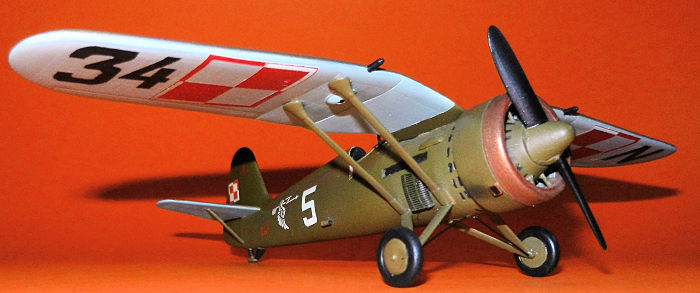 LTD produced in the early 90s some kits that no one
wanted to tackle in 1/48…and that no one else has issued yet like the Romanian
IAR80. These were limited run kits made in the US and as such they had a
considerable amount of flash and several improvements could be made to enhance
the quality of the finished product.
LTD produced in the early 90s some kits that no one
wanted to tackle in 1/48…and that no one else has issued yet like the Romanian
IAR80. These were limited run kits made in the US and as such they had a
considerable amount of flash and several improvements could be made to enhance
the quality of the finished product.
The kit features an excellent representation of the corrugated surface of the wings. It also has two vacuum canopy copies and an excellent decal sheet with several options. The box, with their distinctive blue ink, shows W. Gnys plane during his attack to the two Do17 on September 1 1939.
| CONSTRUCTION |
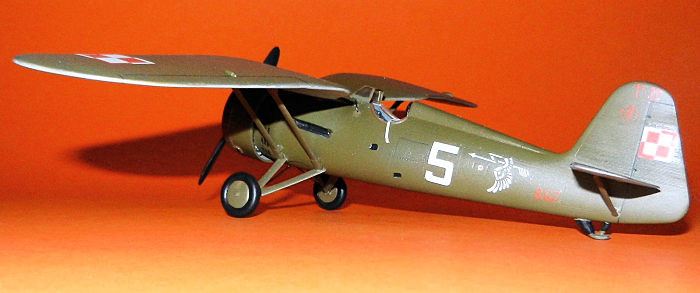 Cockpit has the frames molded in and the instrument
panel has raised details that allow you to highlight those details (I dry
brushed them in silver and painted the dials face using drops of gloss varnish).
A seat and stick complete the interior. The fuselage halves went together with
no fuss requiring practically no putty along the joint line.
Cockpit has the frames molded in and the instrument
panel has raised details that allow you to highlight those details (I dry
brushed them in silver and painted the dials face using drops of gloss varnish).
A seat and stick complete the interior. The fuselage halves went together with
no fuss requiring practically no putty along the joint line.
The central section of the wing was next and once in place the two wings were glued with their supports following at almost the same time to ensure the proper alignment. Landing gear minus wheels came next. The tail planes (leaving the struts for later) were the last major component for the main construction.
The propeller was cleaned up and the engine cowling was assembled with the interior painted in aluminum. These were set aside. The landing gear skid was glued to help during the painting process. I was gladly surprised by the little amount of putty that was required on this limited run kit.
| COLORS & MARKINGS |
This kit was assembled while I was living in Argentina and at the time I was still using paints from the Humbrol range. Thus Humbrol 155 was the color used for most of the surfaces with Humbrol 65 for the undersides. Black was used for the propellers and the wheels and small details (head rest, tail skid, radiator among others). A coat of gloss varnish was all that was needed to get the plane ready for the next step.
 As stated early the decals are excellent. There was no
need to use Set or Sol even on the corrugated wing surfaces. They adhered very
well and were thin with good color density and register. Needless to say I went
with W. Gnys White 5.
As stated early the decals are excellent. There was no
need to use Set or Sol even on the corrugated wing surfaces. They adhered very
well and were thin with good color density and register. Needless to say I went
with W. Gnys White 5.
The frame of the windshield was hand painted and had a very good fit after it was trimmed accordingly. The cushioned edge of the cockpit was painted in brown. Seat belts were scratchbuilt and left hanging out of the fuselage. The tail struts and the wheels were added. With the collector ring painted in bronze and drybrushed with rust the cowling was attached to the fuselage. The propeller came next.
Several openings were highlighted with a dark pencil or with a very thin brush with black paint (i.e. machine guns on the fuselage). The cockpit handles were pretty crude so I replaced them with pieces of wire that I shaped accordingly. Gunsight came from a set of photoetched parts. The venturi was also somehow improved. The extra supports for the landing gear were added using wires. Finally the two wing machine guns were added and my PZL 11c was complete.
| CONCLUSIONS |
A good limited run kit that using a little bit of extra work faithfully depicts an iconic fighter from the early days of WWII.
| REFERENCES |
FIRST KILLS: The Illustrative Biography of Fighter Pilot Władysław Gnyś (S. Gnyś)
Skalski: Against all odds (F. Grabowski)
27 August 2020
Copyright ModelingMadness.com
With thanks to: Stephan Gnys, Mike Parry.
If you would like your product reviewed fairly and fairly quickly, please contact the editor or see other details in the Note to Contributors.
Back to the Main Page Back to the Review Index Page Back to the Previews Index Page